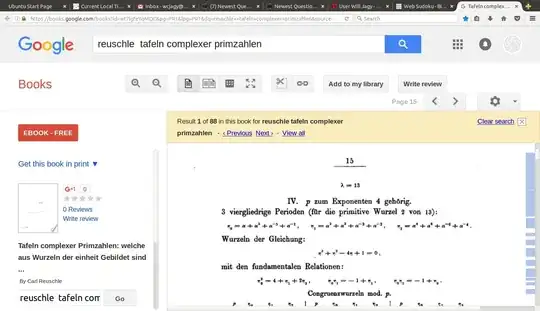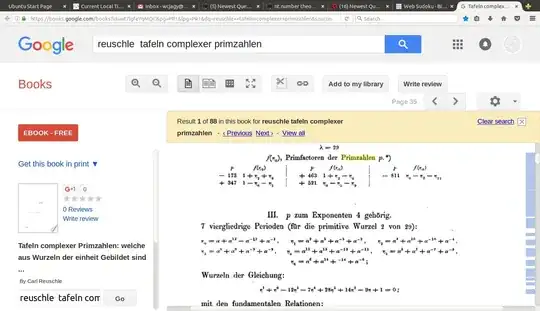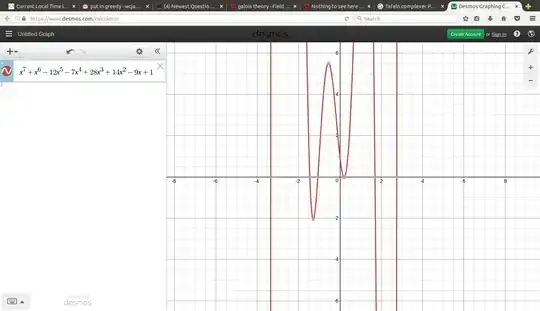Just for laughs, the roots are
$$ 2 \cos \left( \frac{\pi}{13} \right) + 2 \cos \left( \frac{5\pi}{13} \right), $$
$$ 2 \cos \left( \frac{3\pi}{13} \right) + 2 \cos \left( \frac{11\pi}{13} \right), $$
$$ 2 \cos \left( \frac{7\pi}{13} \right) + 2 \cos \left( \frac{9\pi}{13} \right). $$
Reuschle uses $x^3 + x^2 - 4 x + 1$ which is what you get by the method of Gauss, see page 15, jpeg below. I recommend Galois Theory by David A. Cox, chapter 9 for a modern exposition. Method introduced by Gauss in Section VII of the Disquisitiones, some 30 years before Galois Theory. Gauss did few examples, it does take some practice.

Why not: here is a jpeg from the AbeBooks site, showing how to order Reuschle(1875) as a paperback on-demand reprint. The reprint is from a free online source, they don't have a big library of actual old books there at the printing location. I really prefer having actual books to read rather than just on a computer screen.

I wrote programs in November and December (2016) to do this. So, here is the whole song and dance for degree 7, prime 29:
jagy@phobeusjunior:~$ ls -l | grep septic | grep greedy
-rwxrwxr-x 1 jagy jagy 370501 Dec 4 14:11 septic_cyclic_gauss_greedy
-rw-rw-r-- 1 jagy jagy 23990 Dec 4 14:12 septic_cyclic_gauss_greedy.cc
-rw-rw-r-- 1 jagy jagy 23989 Dec 4 14:12 septic_cyclic_gauss_greedy.cc~
jagy@phobeusjunior:~$
jagy@phobeusjunior:~$ ./septic_cyclic_gauss_greedy 29
g to the e 12
1 12 generator
2 28
3 17 generator
1 12 17 28
a 2
h1
1 12 17 28
h2
2 5 24 27
h4
4 10 19 25
h8
8 9 20 21
h16
11 13 16 18
h32
3 7 22 26
h64
6 14 15 23
=-=-=-=-=-=-=-=-=-=-=-=-=-=-=-=-=-=-=-=-=-=-=-=-=-=-=-=-=-=-=-=-=-=-=-=-=-=-=-=-=-=-=-=-=-=-=-=-=-=-=-=-=
h1_1 4 0 1 0 0 2 0 0
h1_2 0 1 0 1 0 0 1 1
h1_4 0 0 1 0 1 1 1 0
h1_8 0 0 0 1 2 0 1 0
h1_16 0 2 0 1 0 0 0 1
h1_32 0 0 1 1 1 0 0 1
h1_64 0 0 1 0 0 1 1 1
=-=-=-=-=-=-=-=-=-=-=-=-=-=-=-=-=-=-=-=-=-=-=-=-=-=-=-=-=-=-=-=-=-=-=-=-=-=-=-=-=-=-=-=-=-=-=-=-=-=-=-=-=
h1_1 4 0 1 0 0 2 0 0
h2_2 4 0 0 1 0 0 2 0
h4_4 4 0 0 0 1 0 0 2
h8_8 4 2 0 0 0 1 0 0
h16_16 4 0 2 0 0 0 1 0
h32_32 4 0 0 2 0 0 0 1
h64_64 4 1 0 0 2 0 0 0
=-=-=-=-=-=-=-=-=-=-=-=-=-=-=-=-=-=-=-=-=-=-=-=-=-=-=-=-=-=-=-=-=-=-=-=-=-=-=-=-=-=-=-=-=-=-=-=-=-=-=-=-=
constant 1 0 0 0 0 0 0 0
linear 0 1 0 0 0 0 0 0
fifth 0 100 11 50 15 5 25 50
sixth 400 21 225 56 105 300 126 91
seventh 84 1225 294 756 392 189 477 742
7 sofar 84 1225 294 756 392 189 477 742
6 sofar 484 1246 519 812 497 489 603 833
fourth 36 0 16 1 4 24 6 4
cubed 0 9 0 3 0 0 1 3
squared 4 0 1 0 0 2 0 0
5 sofar 484 46 387 212 317 429 303 233
table
1 3/4 0 1/4 -233/4
1 1/6 0 1/6 -101/2
1 0 1/12 1/24 -143/8
1 0 0 1/4 -317/4
1 3 0 1 -212
1 0 1/16 1/16 -387/16
=-=-=-=-=-=-=-=-=-=-=-=-=-=-=-=-=-=-=-=-=-=-=-=-=-=-=-=-=-=-=-=-=-=-=-=-=
1 0 0 0 -7
0 1 0 0 28
0 0 1 0 14
0 0 0 1 -289
0 0 0 0 0
0 0 0 0 0
4 sofar 232 46 275 205 289 261 261 205
3 sofar 232 298 275 289 289 261 289 289
2 sofar 288 298 289 289 289 289 289 289
1 sofar 288 289 289 289 289 289 289 289
0 sofar 289 289 289 289 289 289 289 289
confirm 0 0 0 0 0 0 0 0
x^7 + x^6 - 12 x^5 - 7 x^4 + 28 x^3 + 14 x^2 - 9 x + 1
constant 289
p 29 p.root 2 exps 12^k
list of the 4 exponents
1 12 17 28
$$ x^7 + x^6 - 12 x^5 - 7 x^4 + 28 x^3 + 14 x^2 - 9 x + 1, \; \; p = 29, \; \; r = 2, \; \; 12^k $$
gp-pari:
x^7 + x^6 - 12 * x^5 - 7 * x^4 + 28 * x^3 + 14 * x^2 - 9 * x + 1
x = t + (1/t) + t^12 + (1/t^12)
jagy@phobeusjunior:~$

parisize = 4000000, primelimit = 500509
? f = x^7 + x^6 - 12 * x^5 - 7 * x^4 + 28 * x^3 + 14 * x^2 - 9 * x + 1
%1 = x^7 + x^6 - 12*x^5 - 7*x^4 + 28*x^3 + 14*x^2 - 9*x + 1
? polroots(f)
%2 = [
-3.347297326211866604824677822 + 0.E-28*I,
-1.453219237250277575521353021 + 0.E-28*I,
-1.063840303785358166816481464 + 0.E-28*I,
0.1723984388388905398234384116 + 0.E-28*I,
0.2395267590849948773703028220 + 0.E-28*I,
1.700463948582122544295969145 + 0.E-28*I,
2.751967720741494385672801928 + 0.E-28*I]~
?
some of these roots are
$$ 2 \cos \left( \frac{2 \pi}{29} \right) + 2 \cos \left( \frac{24 \pi}{29} \right) = 2 \cos \left( \frac{2 \pi}{29} \right) - 2 \cos \left( \frac{5 \pi}{29} \right) \approx 0.239526759 $$
$$ 2 \cos \left( \frac{4 \pi}{29} \right) + 2 \cos \left( \frac{48 \pi}{29} \right) = 2 \cos \left( \frac{4 \pi}{29} \right) + 2 \cos \left( \frac{10 \pi}{29} \right) \approx 2.75196772 $$
$$ 2 \cos \left( \frac{8 \pi}{29} \right) + 2 \cos \left( \frac{96 \pi}{29} \right) = 2 \cos \left( \frac{8 \pi}{29} \right) - 2 \cos \left( \frac{9 \pi}{29} \right) \approx 0.1723984 $$
$$ 2 \cos \left( \frac{16 \pi}{29} \right) + 2 \cos \left( \frac{192 \pi}{29} \right) = -2 \cos \left( \frac{13 \pi}{29} \right) - 2 \cos \left( \frac{11 \pi}{29} \right) \approx -1.06384 $$
$$ 2 \cos \left( \frac{32 \pi}{29} \right) + 2 \cos \left( \frac{384 \pi}{29} \right) = -2 \cos \left( \frac{3 \pi}{29} \right) - 2 \cos \left( \frac{7 \pi}{29} \right) \approx -3.347297326 $$
$$ 2 \cos \left( \frac{64 \pi}{29} \right) + 2 \cos \left( \frac{768 \pi}{29} \right) = 2 \cos \left( \frac{6 \pi}{29} \right) + 2 \cos \left( \frac{14 \pi}{29} \right) \approx 1.70046 $$
$$ 2 \cos \left( \frac{128 \pi}{29} \right) + 2 \cos \left( \frac{1536 \pi}{29} \right) = 2 \cos \left( \frac{12 \pi}{29} \right) - 2 \cos \left( \frac{ \pi}{29} \right) \approx -1.4532 $$






